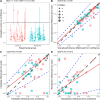Hoarding titmice predominantly use Familiarity, and not Recollection, when remembering cache locations
- PMID: 37865619
- PMCID: PMC10769918
- DOI: 10.1007/s10071-023-01829-3
Hoarding titmice predominantly use Familiarity, and not Recollection, when remembering cache locations
Abstract
Scatter-hoarding birds find their caches using spatial memory and have an enlarged hippocampus. Finding a cache site could be achieved using either Recollection (a discrete recalling of previously experienced information) or Familiarity (a feeling of "having encountered something before"). In humans, these two processes can be distinguished using receiver operating characteristic (ROC) curves. ROC curves for olfactory memory in rats have shown the hippocampus is involved in Recollection, but not Familiarity. We test the hypothesis that food-hoarding birds, having a larger hippocampus, primarily use Recollection to find their caches. We validate a novel method of constructing ROC curves in humans and apply this method to cache retrieval by coal tits (Periparus ater). Both humans and birds mainly use Familiarity in finding their caches, with lower contribution of Recollection. This contribution is not significantly different from chance in birds, but a small contribution cannot be ruled out. Memory performance decreases with increasing retention interval in birds. The ecology of food-hoarding Parids makes it plausible that they mainly use Familiarity in the memory for caches. The larger hippocampus could be related to associating cache contents and temporal context with cache locations, rather than Recollection of the spatial information itself.
Keywords: Cognitive evolution; Comparative cognition; Episodic-like memory; Hippocampus; Periparus ater; Scatter-hoarding.
© 2023. The Author(s).
Conflict of interest statement
The authors have no competing interests to declare.
Figures




References
-
- Brodin A. The disappearance of caches that have been stored by naturally foraging willow tits. Anim Behav. 1994;47:730–732. doi: 10.1006/anbe.1994.1100. - DOI
MeSH terms
Grants and funding
LinkOut - more resources
Full Text Sources

